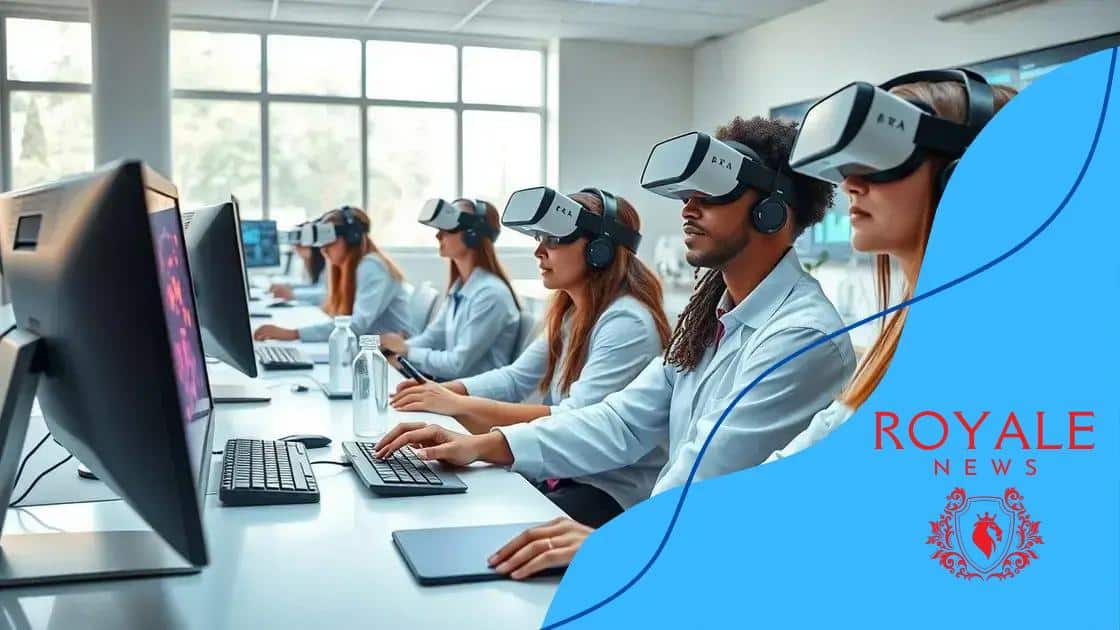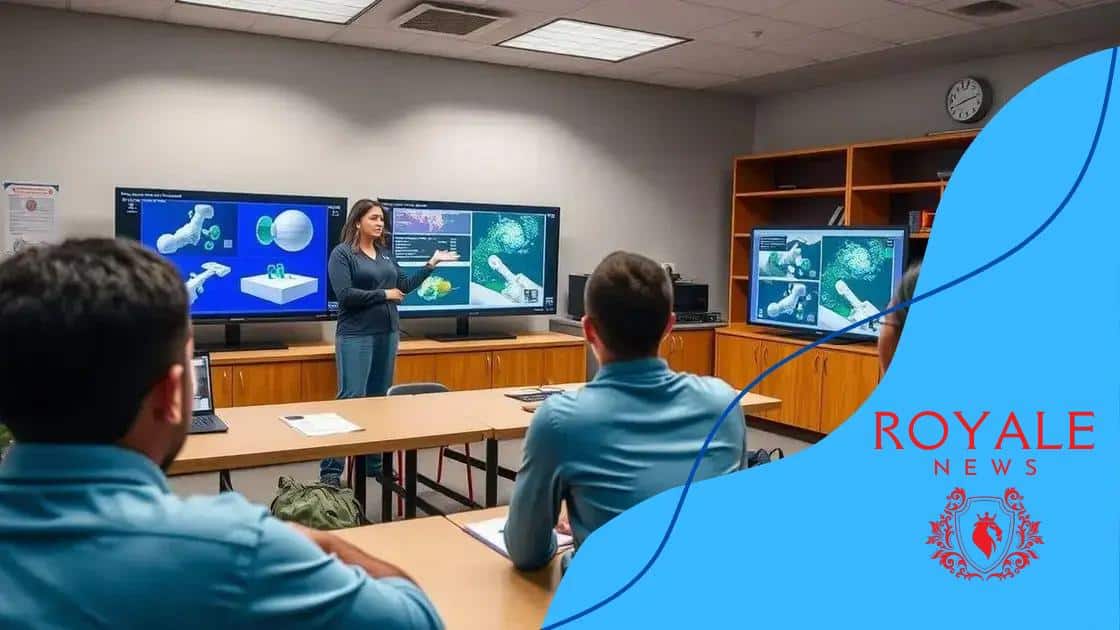Virtual labs in STEM education boost student engagement

Virtual labs in STEM education offer interactive and safe environments for students to conduct experiments, utilizing advanced technologies like AI and VR to enhance learning and engagement.
Virtual labs in STEM education are transforming the way students interact with science and technology. Imagine conducting experiments without being confined to a physical lab! This innovative approach offers exciting opportunities for deeper learning and skill development.
Understanding the concept of virtual labs
Understanding the concept of virtual labs is essential for grasping how technology enhances STEM education. These labs provide a dynamic learning environment where students can explore scientific concepts through simulations.
They replicate traditional laboratory environments by offering interactive experiences. Instead of just reading about theories, students can conduct experiments and observe results in real-time, making learning more engaging.
What are virtual labs?
Virtual labs are online platforms that enable students to perform experiments remotely. They utilize advanced software to mimic real-life lab scenarios, allowing for hands-on learning opportunities.
Using these labs, students can:
- Explore various scientific principles interactively.
- Access a wide range of experiments without the need for physical materials.
- Work at their own pace, which caters to different learning styles.
This flexibility is a key advantage of virtual labs. Furthermore, students can collaborate with peers, sharing insights and results, which cultivates teamwork and communication skills.
The technology behind virtual labs
The development of virtual labs involves sophisticated technologies such as simulations, augmented reality, and virtual reality. These tools work together to create immersive experiences that replicate real-life lab conditions.
Simulations allow students to visualize processes that would be difficult to demonstrate in a physical lab space. For instance, chemistry experiments that require specific conditions can be performed virtually, enabling students to understand concepts better. Using augmented reality, students can interact with 3D models, enhancing their comprehension of complex subjects.
As technology continues to evolve, the opportunities for virtual labs will expand, making science education more accessible and engaging for everyone.
Benefits of virtual labs in STEM education
The benefits of virtual labs in STEM education are significant and transformative. By utilizing these labs, students can experience practical learning without the constraints of traditional classrooms.
One major advantage is accessibility. Students can engage with complex scientific concepts from anywhere, making learning more inclusive. Rather than being limited by geography or available materials, anyone with internet access can explore STEM experiments in depth.
Enhancing engagement and motivation
Another benefit is the increased engagement and motivation among students. Virtual labs provide interactive experiences that can capture students’ attention better than textbooks or lectures.
- Real-time feedback during experiments helps students learn from their mistakes.
- Gamified elements can make learning fun and exciting.
- Students can explore at their own pace, fostering a sense of independence.
This level of engagement encourages students to delve deeper into subjects, enhancing critical thinking and problem-solving skills.
Safe learning environment
Additionally, virtual labs create a safe environment for students to explore. In traditional labs, safety is a major concern. Students can accidentally spill chemicals or misuse equipment. However, in virtual settings, they can interact with simulations without real-world risks.
For instance, they can conduct chemical reactions or perform biology dissections without any hazards. This freedom allows students to experiment and learn through trial and error in a way that would be unsafe in a physical lab.
Lastly, virtual labs promote collaboration and teamwork. Many platforms allow students to work together on experiments, sharing results and insights. This interactive collaboration not only enhances understanding but also develops communication skills that are crucial in any STEM career.
How to effectively integrate virtual labs in classrooms

Integrating virtual labs into classrooms effectively is key to enhancing STEM education. With the right approach, teachers can create an engaging learning environment that maximizes the benefits of technology.
First, it is essential to choose the right platform that fits the curriculum. There are many options available, and selecting one that is user-friendly and aligned with the educational goals is crucial. This ensures that both teachers and students can navigate the virtual lab easily.
Training educators
Teachers should receive proper training on how to use these virtual labs. Professional development sessions can help instructors feel confident in facilitating virtual experiments. When teachers are comfortable with technology, they can guide students more effectively.
- Provide hands-on training sessions to familiarize teachers with the tools.
- Encourage collaboration among educators to share best practices.
- Offer resources and support for troubleshooting common issues.
Once teachers are equipped, planning lessons that incorporate virtual labs is the next step. Educators should align lab activities with specific learning objectives, ensuring that each lab reinforces key concepts. This targeted approach helps students see the relevance of what they are learning.
Encouraging student collaboration
Another effective strategy is to encourage collaboration among students during virtual lab activities. Group projects can foster teamwork and enhance learning outcomes. Students can work together to discuss their findings, troubleshoot issues, and share insights.
Moreover, providing opportunities for reflection helps students solidify their understanding. After completing a virtual lab, teachers can facilitate discussions or have students write about their experiences. This reflection deepens their grasp of the material and encourages critical thinking.
As technology evolves, integrating virtual labs into classrooms will become increasingly important. By adopting these strategies, educators can provide students with valuable hands-on experiences, no matter where they are learning.
Challenges and solutions in implementing virtual labs
Implementing virtual labs brings various challenges that educators must navigate. Understanding these obstacles is crucial for ensuring a smooth transition into this innovative approach to STEM education.
One common challenge is the technology barrier. Not all schools have the necessary infrastructure, such as high-speed internet and devices capable of running sophisticated simulations. This can make access uneven and limit the benefits of virtual labs.
Addressing technology barriers
To overcome this issue, schools can explore several solutions:
- Invest in updated technology and ensure reliable internet access.
- Offer training sessions for staff to familiarize them with the technology.
- Seek partnerships with tech companies for resources and support.
Another hurdle is ensuring that both teachers and students are comfortable using the platforms. If educators lack confidence, this may lead to ineffective use of virtual labs.
Providing adequate training
Providing proper training for teachers is essential. Schools should facilitate workshops that cover the necessary skills to navigate virtual labs. Additionally, ongoing support may help teachers adjust to new technologies as they evolve.
Students also need guidance. Many may require orientation on how to use new tools efficiently. Creating easy-to-follow resource materials can assist them in becoming adept users.
Moreover, some educators may worry about the effectiveness of virtual labs compared to traditional learning. They might question whether students will achieve the same level of understanding without hands-on lab experiences.
Enhancing effectiveness
To address these concerns, it is important to integrate traditional and virtual methods. Utilizing hybrid models where students can participate in both types of labs can enhance learning outcomes.
By actively engaging students and combining resources from both platforms, teachers can create a more enriching learning environment. Finally, collecting feedback from students and educators can help improve the implementation process over time. Understanding what works and what doesn’t allows for continuous enhancements in using virtual labs effectively.
Future trends in virtual labs for STEM learning
The future of virtual labs in STEM learning is bright and full of possibilities. As technology advances, so do the opportunities for students to engage in innovative and interactive ways.
One trend is the integration of artificial intelligence in virtual labs. AI can personalize learning experiences, adapting to each student’s needs. This means that students will receive tailored feedback and support, enhancing their understanding of complex concepts.
Augmented and virtual reality
Another exciting development is the use of augmented reality (AR) and virtual reality (VR)
The rise of collaborative learning platforms also indicates a shift in how students interact with virtual labs. Online tools allow students to work together in virtual settings, promoting teamwork and communication skills. Additionally, data analytics will play a key role in the future of virtual labs. Educators can track student progress and identify areas where they struggle. This data can inform instructional strategies, helping teachers provide targeted support. Moreover, as educational institutions embrace STEM education, more funding will likely be allocated to enhance virtual lab technologies. This investment can lead to higher quality resources and more engaging experiences for students. Overall, the evolution of virtual labs promises to revolutionize STEM learning. With advancements in technology and a focus on student-centered practices, the future looks promising for educators and learners alike. In conclusion, virtual labs are transforming the landscape of STEM education. They provide students with engaging, safe, and innovative learning experiences that traditional labs often cannot match. By integrating advanced technologies like AI, AR, and VR, educators are paving the way for personalized and interactive learning. The future of virtual labs is bright, offering even more opportunities for collaboration and understanding. As these technologies evolve, they will continue to enhance STEM learning, making science and technology accessible and exciting for all students. Virtual labs are online platforms that allow students to perform science experiments through interactive simulations, making learning engaging. Virtual labs provide safe, hands-on experiences that deepen understanding and encourage critical thinking, often surpassing traditional lab setups. Virtual labs utilize various technologies, including artificial intelligence, augmented reality, and virtual reality, to create immersive learning experiences. Teachers can integrate virtual labs by selecting appropriate platforms, receiving training, and planning lessons that align with learning objectives to ensure effective use.
Data analytics for better insights
FAQ – Frequently Asked Questions about Virtual Labs in STEM Education
What are virtual labs?
How do virtual labs enhance student learning?
What technologies are used in virtual labs?
How can teachers effectively integrate virtual labs into their classrooms?





